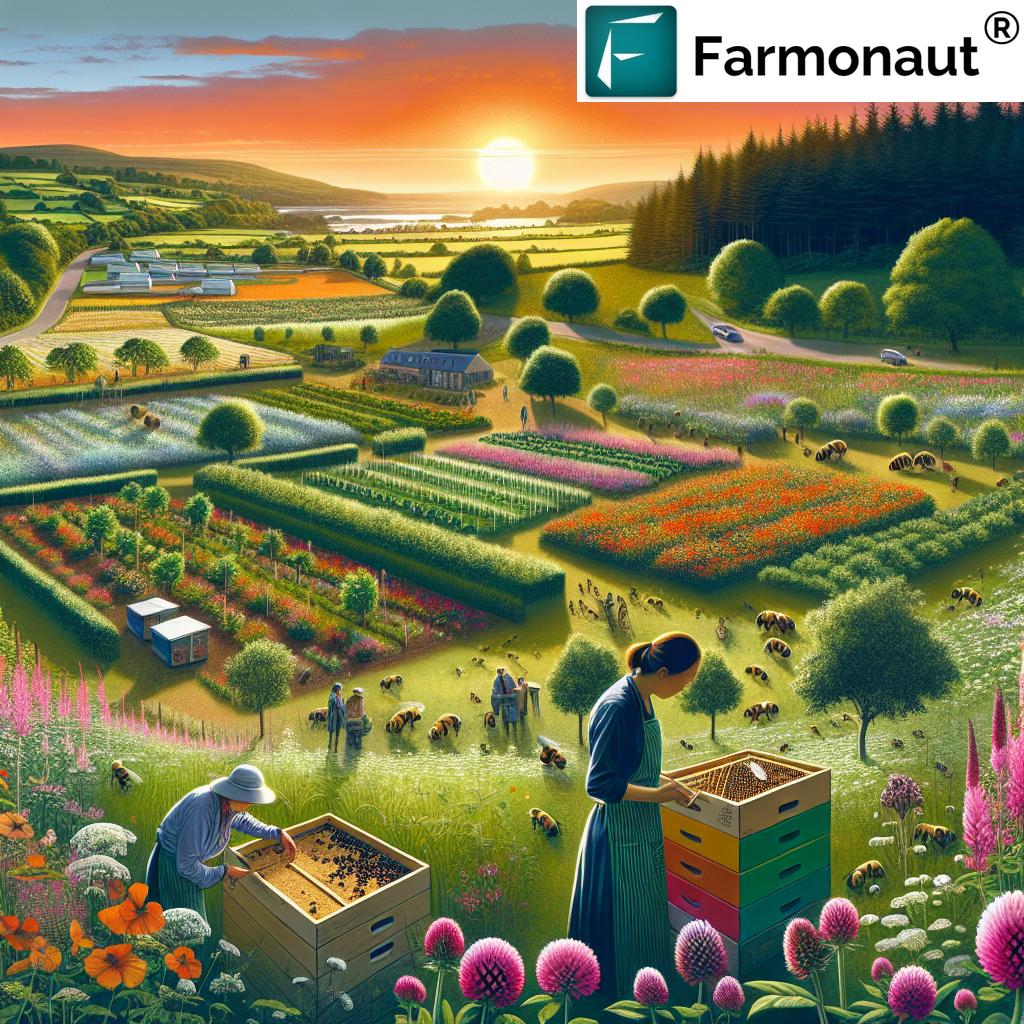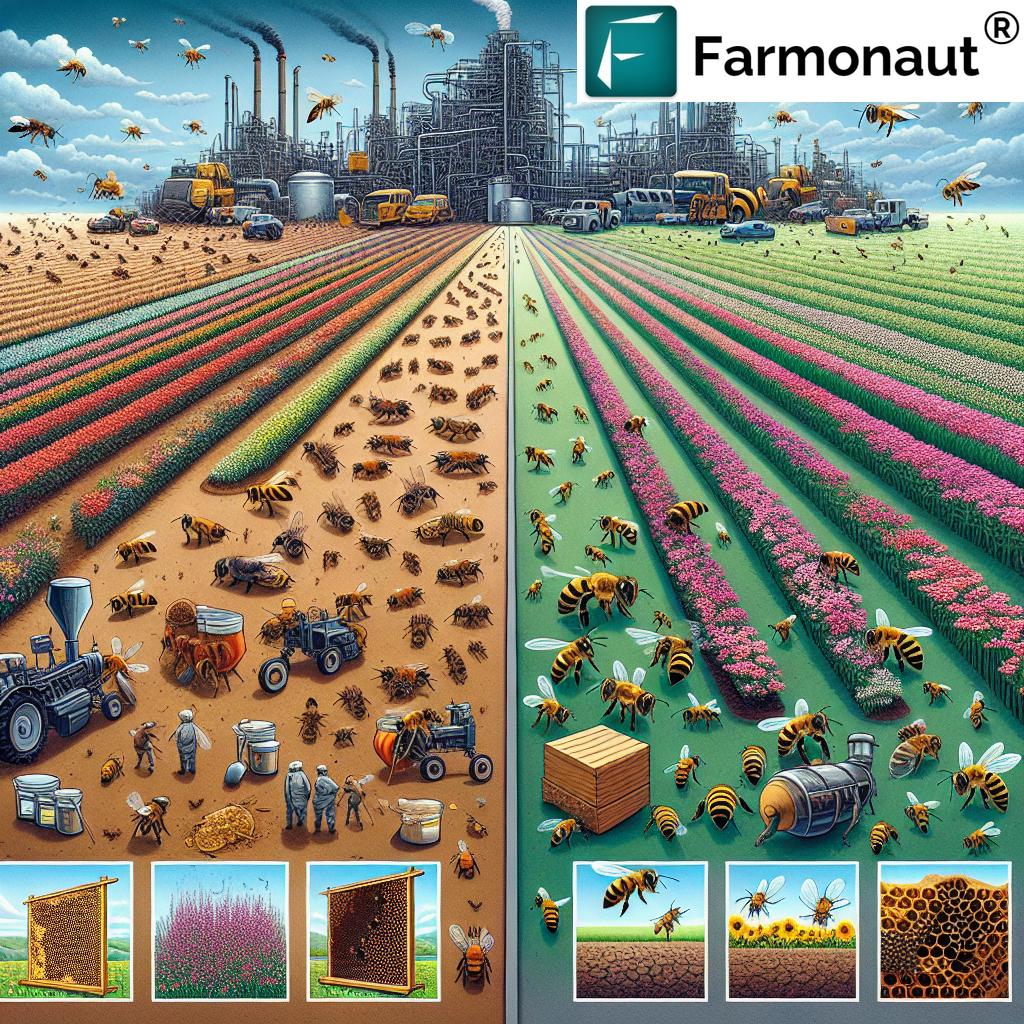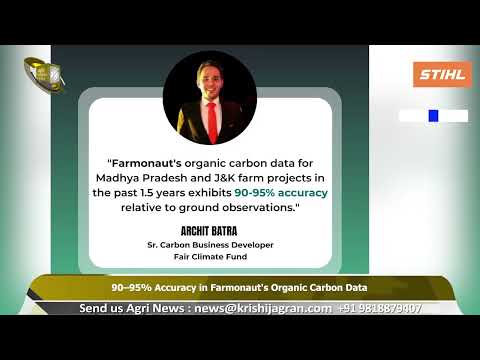Saving Scotland’s Bees: Sustainable Farming Solutions for Pollinator Protection and Biodiversity
“Scotland’s bee populations have declined by up to 60% in recent years due to pesticides, varroa mites, and habitat loss.”
Welcome to our comprehensive exploration of the critical challenges facing Scotland’s bee populations and the sustainable farming solutions that offer hope for their protection and the preservation of biodiversity. As we delve into this crucial topic, we’ll uncover the intricate connections between bees, organic farming methods, and ecological balance, while highlighting the role of innovative agritech solutions in supporting pollinator-friendly agriculture.
The Buzz on Bees: Why They Matter
Bees are more than just producers of honey; they are vital pollinators that play a crucial role in sustainable agriculture and maintaining biodiversity. In Scotland and across the UK, these industrious insects are responsible for pollinating a wide variety of crops, including fruits, vegetables, and oilseed rape. Their importance extends far beyond our farms and gardens, as they also pollinate wildflowers and contribute to the overall health of our ecosystems.
However, bee populations in Scotland and around the world are facing unprecedented dangers. In this blog post, we’ll explore three major threats to bee populations: pesticides, varroa mites, and habitat loss. We’ll also discuss how intensive farming practices and synthetic chemicals create a deadly “cocktail effect” that devastates bee colonies and biodiversity.
The Triple Threat: Pesticides, Varroa Mites, and Habitat Loss
1. The Pesticide Predicament
One of the most significant challenges facing bee populations is the widespread use of pesticides in conventional farming. Neonicotinoids, a class of systemic insecticides, have been particularly harmful to bees. These chemicals can persist in the environment for long periods and are absorbed by plants, making their way into pollen and nectar.
The impact of pesticides on bees is multifaceted:
- Impaired navigation and foraging abilities
- Weakened immune systems
- Reduced fertility in queen bees
- Disruption of colony social structures
The “cocktail effect” occurs when bees are exposed to multiple pesticides simultaneously, amplifying their toxic effects. This combination of chemicals can be lethal to bees, even at levels considered safe when individual pesticides are assessed in isolation.
2. The Varroa Mite Menace
Varroa destructor, a parasitic mite, has become a significant threat to honeybee colonies across Scotland and the UK. These tiny arachnids attach themselves to bees and feed on their hemolymph (bee blood), weakening the insects and making them more susceptible to diseases.
The varroa mite’s impact on bee colonies includes:
- Transmission of viruses and other pathogens
- Reduced lifespan of infected bees
- Deformed wing virus in developing bees
- Weakened overall colony health
The presence of varroa mites in bee colonies has been linked to Colony Collapse Disorder (CCD), a phenomenon where worker bees mysteriously disappear from a hive, leaving behind the queen and young bees.
3. Habitat Loss: A Vanishing Landscape
The third major threat to Scotland’s bees is the alarming disappearance of wildflower meadows and suitable habitats. Intensive farming practices, urban expansion, and climate change have all contributed to this loss of biodiversity.
Key factors contributing to habitat loss include:
- Conversion of wildflower meadows to cropland
- Removal of hedgerows and field margins
- Use of herbicides that eliminate wildflowers
- Urban development encroaching on natural areas
The loss of diverse floral resources means bees have fewer food sources and nesting sites, leading to declining populations and reduced genetic diversity.

Sustainable Farming Solutions: A Ray of Hope for Bees
While the challenges facing Scotland’s bees are significant, there is hope on the horizon. Sustainable farming practices and innovative agritech solutions offer promising ways to protect pollinators and promote biodiversity. Let’s explore some of these solutions:
1. Organic Farming: Nurturing Nature’s Balance
Organic farming methods prioritize ecological balance and biodiversity, making them inherently bee-friendly. By avoiding synthetic pesticides and focusing on natural pest control methods, organic farms provide safer environments for pollinators.
Key aspects of organic farming that benefit bees include:
- Crop rotation and intercropping to reduce pest pressures
- Use of natural predators and beneficial insects for pest control
- Maintenance of diverse habitats, including hedgerows and wildflower strips
- Emphasis on soil health, which supports diverse plant communities
Farmonaut’s satellite-based crop health monitoring can assist organic farmers in optimizing their practices by providing real-time insights into vegetation health and soil moisture levels. This data-driven approach enables farmers to make informed decisions about irrigation and pest management without relying on harmful chemicals.
2. Integrated Pest Management (IPM): A Holistic Approach
Integrated Pest Management is a sustainable approach to pest control that minimizes the use of pesticides while maximizing crop protection. This strategy combines various techniques to manage pests effectively while reducing harm to beneficial insects like bees.
IPM techniques include:
- Regular monitoring of pest populations
- Use of pest-resistant crop varieties
- Biological control methods (e.g., introducing natural predators)
- Targeted application of pesticides only when necessary
Farmonaut’s Jeevn AI Advisory System can play a crucial role in implementing effective IPM strategies. By analyzing satellite data and other inputs, this AI-driven tool can provide farmers with personalized advice on pest management, helping them make informed decisions that protect both crops and pollinators.
3. Habitat Creation and Conservation
Restoring and creating suitable habitats for bees is essential for their long-term survival. Farmers and landowners can take several steps to support pollinator populations:
- Planting wildflower meadows and pollinator-friendly crops
- Maintaining hedgerows and field margins
- Creating nesting sites for solitary bees
- Reducing mowing frequency in grassy areas
Farmonaut’s satellite imagery can help farmers identify areas suitable for habitat creation and monitor the success of these efforts over time. By providing detailed vegetation maps, Farmonaut enables farmers to make data-driven decisions about land use that benefit both agriculture and biodiversity.
“Over 75% of global food crops rely on pollinators like bees, highlighting their crucial role in sustainable agriculture.”
Agroforestry and Agroecology: Building Resilient Landscapes
Agroforestry and agroecology are innovative approaches to agriculture that can create resilient landscapes for pollinators while maintaining productive farming systems.
Agroforestry: Trees and Crops in Harmony
Agroforestry integrates trees and shrubs into agricultural systems, providing numerous benefits for bees and other pollinators:
- Diverse floral resources throughout the growing season
- Shelter and nesting sites for pollinators
- Improved microclimates that buffer against extreme weather
- Enhanced soil health and water retention
Farmonaut’s satellite-based monitoring can help farmers design and manage effective agroforestry systems by providing insights into tree growth, crop health, and overall system performance.
Agroecology: Farming with Nature
Agroecology applies ecological principles to agricultural systems, promoting biodiversity and sustainable practices. This approach benefits bees by:
- Encouraging diverse crop rotations that provide varied food sources
- Minimizing synthetic inputs that can harm pollinators
- Promoting natural pest control through ecological balance
- Enhancing landscape diversity to support pollinator populations
Farmonaut’s AI-powered advisory system can support agroecological practices by providing farmers with tailored recommendations for crop rotations, pest management, and resource optimization based on real-time data and ecological principles.
Explore Farmonaut’s API for advanced agricultural insights
The Role of Technology in Pollinator Protection
Innovative agritech solutions are playing an increasingly important role in supporting pollinator-friendly agriculture and sustainable farming practices. Let’s explore how technology is helping to protect Scotland’s bees:
1. Precision Agriculture for Reduced Chemical Use
Precision agriculture techniques, powered by satellite imagery and AI, allow farmers to apply inputs like fertilizers and pesticides more accurately and efficiently. This targeted approach reduces overall chemical use, minimizing the impact on bees and other beneficial insects.
Farmonaut’s satellite-based crop health monitoring is at the forefront of this technology, providing farmers with detailed insights into their fields’ conditions. By identifying areas that require attention, farmers can address issues precisely, reducing the need for broad-spectrum pesticide applications.
2. AI-Powered Pest Prediction and Management
Artificial intelligence is revolutionizing pest management by predicting outbreaks before they occur. This proactive approach allows farmers to implement preventive measures, reducing the reliance on chemical pesticides.
Farmonaut’s Jeevn AI Advisory System analyzes historical data, weather patterns, and current field conditions to forecast potential pest issues. By providing early warnings and targeted management strategies, this technology helps farmers protect their crops while minimizing harm to pollinators.
3. Remote Sensing for Habitat Monitoring
Satellite imagery and remote sensing technologies are valuable tools for monitoring and protecting bee habitats. These technologies allow researchers and conservationists to track changes in land use, identify areas of high biodiversity, and assess the health of pollinator-friendly landscapes.
Farmonaut’s advanced satellite imagery can be used to map and monitor wildflower meadows, hedgerows, and other important bee habitats. This information helps guide conservation efforts and sustainable land management practices that support pollinator populations.
4. Blockchain for Sustainable Supply Chains
Blockchain technology is being used to create transparent and traceable supply chains in agriculture. This transparency can incentivize sustainable farming practices that protect pollinators by allowing consumers to make informed choices about the products they purchase.
Farmonaut’s blockchain-based traceability solution enables farmers and food producers to demonstrate their commitment to sustainable, bee-friendly practices. By providing verifiable data on farming methods and environmental impacts, this technology helps build consumer trust and support for pollinator-friendly agriculture.
Access Farmonaut’s API Developer Docs for integration details
Regenerative Farming: A Holistic Approach to Pollinator Protection
Regenerative farming practices go beyond sustainability, actively working to improve soil health, increase biodiversity, and enhance ecosystem services. These practices offer significant benefits for bees and other pollinators:
- Minimizing soil disturbance to protect ground-nesting bees
- Increasing plant diversity to provide varied food sources
- Reducing or eliminating synthetic inputs that harm pollinators
- Integrating livestock to create diverse landscapes
Farmonaut’s comprehensive farm management platform can support farmers in transitioning to regenerative practices by providing data-driven insights into soil health, biodiversity metrics, and overall farm ecosystem performance.

Policy and Collaboration: Driving Change for Bee Protection
Protecting Scotland’s bees requires a collaborative effort involving farmers, policymakers, researchers, and the public. Here are some key areas where policy and collaboration can make a difference:
1. Supportive Agricultural Policies
Government policies play a crucial role in promoting bee-friendly farming practices. Initiatives that can help include:
- Financial incentives for adopting pollinator-friendly farming methods
- Support for organic and regenerative farming transitions
- Stricter regulations on pesticide use and testing
- Funding for research into sustainable pest management techniques
2. Urban Planning for Pollinator Protection
As urban areas expand, it’s essential to incorporate pollinator-friendly spaces into city planning. This can involve:
- Creating green corridors to connect fragmented habitats
- Encouraging the planting of native, pollinator-friendly species in public spaces
- Supporting community gardens and urban beekeeping initiatives
- Implementing pollinator-friendly management practices in parks and public lands
3. Education and Public Awareness
Raising awareness about the importance of bees and other pollinators is crucial for garnering public support for conservation efforts. Educational initiatives can include:
- School programs focused on pollinator conservation
- Public workshops on creating bee-friendly gardens
- Information campaigns about the impacts of pesticide use on pollinators
- Promotion of local, sustainably produced honey and other bee products
Farmonaut’s data visualization tools can be used to create compelling educational materials that illustrate the impact of different farming practices on pollinator populations and biodiversity.
The Future of Farming: Balancing Production and Pollinator Protection
As we look to the future of agriculture in Scotland and beyond, it’s clear that protecting pollinators must be a central consideration. The challenge lies in balancing the need for increased food production with the imperative to preserve biodiversity and ecological balance.
Innovative farming approaches that can help achieve this balance include:
- Vertical farming and controlled environment agriculture to reduce land use pressure
- Precision fermentation and cellular agriculture for sustainable protein production
- Advanced plant breeding techniques to develop crops that require fewer inputs
- Integrated crop-livestock systems that enhance biodiversity and soil health
Farmonaut’s agritech solutions are well-positioned to support these innovative approaches by providing the data-driven insights and management tools needed to optimize production while minimizing environmental impact.
Table: Threats to Bee Populations and Sustainable Solutions
| Threat | Impact on Bees | Conventional Farming Practice | Sustainable Solution |
|---|---|---|---|
| Pesticides | Colony collapse, impaired navigation, weakened immune systems | Widespread use of synthetic chemicals | Integrated Pest Management (IPM), organic farming methods |
| Varroa Mites | Disease transmission, reduced lifespan, deformed wing virus | Chemical treatments, antibiotics | Natural pest control, breeding resistant bee strains |
| Habitat Loss | Reduced food sources, fewer nesting sites, genetic isolation | Monoculture farming, removal of hedgerows | Habitat creation, agroforestry, diverse crop rotations |
Conclusion: A Call to Action for Scotland’s Bees
The challenges facing Scotland’s bee populations are significant, but so too are the opportunities for positive change. By embracing sustainable farming practices, leveraging innovative technologies, and fostering collaboration between stakeholders, we can create a future where agriculture thrives alongside healthy pollinator populations.
As we’ve explored in this blog post, the solutions are multifaceted and require a holistic approach. From organic farming and integrated pest management to habitat creation and regenerative practices, there are many ways that farmers, policymakers, and the public can contribute to bee conservation efforts.
Farmonaut’s suite of agritech solutions offers powerful tools to support these efforts, providing farmers with the data-driven insights and management capabilities needed to implement sustainable, pollinator-friendly practices at scale. By harnessing the power of satellite imagery, AI, and blockchain technology, we can create a more resilient and bee-friendly agricultural landscape in Scotland and beyond.
Let’s work together to protect Scotland’s bees, preserve our biodiversity, and secure a sustainable food future for generations to come.
FAQs: Saving Scotland’s Bees
- Q: Why are bees so important for agriculture?
A: Bees are crucial pollinators, responsible for the reproduction of many plant species, including numerous food crops. Their pollination services contribute to higher yields and better quality fruits and vegetables. - Q: How can farmers transition to more bee-friendly practices?
A: Farmers can adopt integrated pest management, reduce pesticide use, plant diverse crops and hedgerows, and create habitat corridors. Farmonaut’s technologies can assist in this transition by providing data-driven insights for sustainable farm management. - Q: What role does technology play in protecting bee populations?
A: Technology like Farmonaut’s satellite imagery and AI-powered advisory systems help farmers optimize resource use, reduce chemical inputs, and monitor crop health, all of which contribute to creating bee-friendly farming environments. - Q: How can consumers support bee conservation efforts?
A: Consumers can support bee conservation by purchasing organic and locally produced foods, planting bee-friendly gardens, and advocating for pollinator-friendly policies in their communities. - Q: What is the “cocktail effect” and why is it dangerous for bees?
A: The cocktail effect refers to the combined impact of multiple pesticides, which can be more toxic to bees than individual chemicals. This synergistic effect can severely harm bee populations even when pesticides are used at levels considered safe individually.




